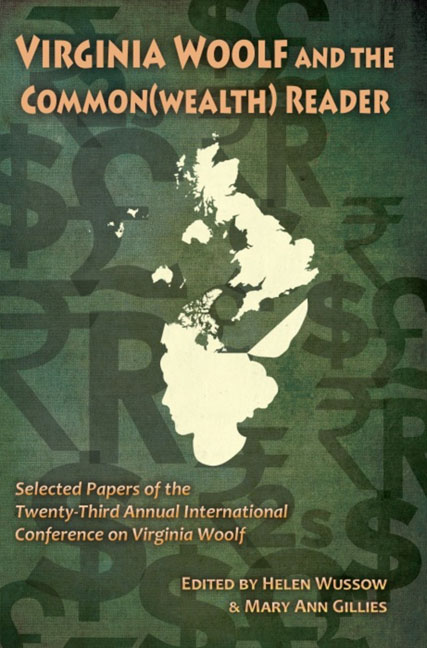Book contents
- Frontmatter
- Contents
- Introduction to Virginia Woolf and the Common(wealth) Reader
- Acknowledgments
- List of Abbreviations
- Invocations
- Networks of Affiliation: Foundations and Friends
- Education and Empire in Victorian Bloomsbury
- Synthesizing Civilizations: Leonard Woolf, the League of Nations, and the Inverse of Imperialism, 1928–1933
- James Stephen's Anti-Slavery Politics: A Woolfian Inheritance
- Networks of Empire: Virginia Woolf and the Travel Writing of Emily Eden
- Of Scrapbooks, War, and Newspapers: Leslie Stephen's Legacy
- Leslie Stephen's Science of (Ecological) Ethics
- “The Death of a Beautiful Man”: Rupert Brooke in Memory and Imagination
- Leonard Woolf and the Ceylon Civil Service: “I had come to dislike imperialism”
- Virginia Woolf in the British Commonwealth
- Woolf and the Commonwealth
- 1930s Onwards
- Woolf Beyond the Book
- Notes on Contributors
- Conference Program
“The Death of a Beautiful Man”: Rupert Brooke in Memory and Imagination
from Networks of Affiliation: Foundations and Friends
- Frontmatter
- Contents
- Introduction to Virginia Woolf and the Common(wealth) Reader
- Acknowledgments
- List of Abbreviations
- Invocations
- Networks of Affiliation: Foundations and Friends
- Education and Empire in Victorian Bloomsbury
- Synthesizing Civilizations: Leonard Woolf, the League of Nations, and the Inverse of Imperialism, 1928–1933
- James Stephen's Anti-Slavery Politics: A Woolfian Inheritance
- Networks of Empire: Virginia Woolf and the Travel Writing of Emily Eden
- Of Scrapbooks, War, and Newspapers: Leslie Stephen's Legacy
- Leslie Stephen's Science of (Ecological) Ethics
- “The Death of a Beautiful Man”: Rupert Brooke in Memory and Imagination
- Leonard Woolf and the Ceylon Civil Service: “I had come to dislike imperialism”
- Virginia Woolf in the British Commonwealth
- Woolf and the Commonwealth
- 1930s Onwards
- Woolf Beyond the Book
- Notes on Contributors
- Conference Program
Summary
Edgar Allan Poe wrote, “The death of a beautiful woman is, unquestionably, the most poetical topic in the world.…And equally is it beyond doubt that the lips best suited for such a topic are those of a bereaved lover”(165). The beautiful man of my title is Rupert Brooke. He and Virginia Woolf were not lovers, though they toyed with the possibility, and she mourned his death in her own poetical way, in Jacob's Room and Mrs. Dalloway. They are elegies of a kind, but distinct from the classical works that preceded them: Lycidas, Adonais, In Memoriam, and Poe's own “The Raven.” In none of these does a woman mourn a man; Woolf mourns Brooke in her novels, but also several other men, and perhaps men in general.
My approach to this poetical topic will be through biography, while also recognizing its limitations. After Jacob's Room was published, Woolf herself asked the question “how far can one convey character without realism?” (L2 571). Jacob is not a “rounded” character of the nineteenth-century kind, nor does an omniscient narrator give us access to all his thoughts and motives. Edward Bishop has argued that Jacob is another kind of subject altogether (“Subject” 141). It is not my aim to intervene in this discussion, but rather to consider how Woolf used people she knew for fi ctional ends, even though a Jacob or a Clarissa are not “realist” representations of Rupert Brooke or Kitty Maxse. In my title, therefore, “memory” stands for Woolf's actual relations with Brooke and other young men, especially her brother Thoby, and “imagination” stands for her freedom to modify those relations in the interest of her fiction. Woolf often made those who were close to her objects of fantasy; in her novels she added the further dimension of fictional license. The phrase she used for this license, in her notes for The Hours, was “founded on”: not “based on” or “modelled on,” as we usually say. She seems to mean that an actual person can be a foundation on which various kinds of new structures can be raised.
- Type
- Chapter
- Information
- Virginia Woolf and the Common(wealth) Reader , pp. 50 - 58Publisher: Liverpool University PressPrint publication year: 2014



